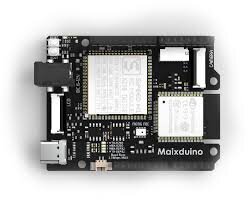The Maixduino is a development board that integrates the Kendryte K210 AI processor, designed for applications in artificial intelligence (AI) and the Internet of Things (IoT). Manufactured by Sipeed, the Maixduino combines the power of the K210 with the connectivity features of the ESP32 module, making it a versatile and powerful tool for developers.
Key Features of the Maixduino
Kendryte K210 AI Processor
The heart of the Maixduino is the Kendryte K210, a system-on-chip (SoC) that excels in machine vision and machine hearing applications. The K210 is built using TSMC’s 28nm process, featuring dual-core 64-bit RISC-V processors clocked at 400 MHz, with the capability to overclock up to 800 MHz. This processor includes a floating-point unit (FPU) and a neural network hardware accelerator known as the KPU (Knowledge Processing Unit), which supports convolutional neural network operations for AI tasks such as object detection and image classification[1][2].
Machine Vision and Hearing Capabilities
The K210’s machine vision capabilities include:
– General target detection
– Image classification
– Face detection and recognition
– Real-time size and coordinate detection of targets
For machine hearing, the K210 offers:
– Sound source orientation
– Sound field imaging
– Beamforming
– Voice wake-up and speech recognition
These features allow the Maixduino to perform complex AI tasks with low power consumption, making it suitable for embedded applications[1].
ESP32 Module
The Maixduino also includes an ESP32 module, which provides WiFi and Bluetooth connectivity. The ESP32 has its own dual-core processor, clocked at 240 MHz, which can handle communication tasks independently, thus offloading these tasks from the K210. This module supports 2.4GHz 802.11.b/g/n WiFi and Bluetooth 4.2, enabling seamless connectivity for IoT applications[2][3].
Hardware and Connectivity
The Maixduino features:
– An OV2640 camera module for image capture
– A digital microphone and audio amplifier for audio processing
– USB Type-C port for power and programming
– Arduino-compatible headers for easy integration with other Arduino components
– Support for various development environments, including Arduino IDE, MaixPy IDE, and OpenMV IDE
The board’s form factor is similar to the Arduino Uno, but it offers significantly more advanced features, making it a powerful alternative for AI and IoT projects[2][3].
Applications
The Maixduino is ideal for a wide range of applications, including:
– Smart home devices (e.g., robotic vacuum cleaners, smart speakers)
– Medical devices
– Industrial automation (Industry 4.0)
– Agricultural technology
– Educational tools for learning AI and IoT development
Overall, the Maixduino provides a comprehensive and cost-effective platform for developers looking to explore AI and IoT applications with the convenience of Arduino compatibility[2][3][4].
[1]: https://maixduino.sipeed.com/en/hardware/k210.html
[2]: https://www.elektormagazine.com/articles/artificial-intelligence-for-beginners-1
[3]: https://core-electronics.com.au/maixduino-ai-development-board-ov2640-k210-risc-v-ai-lot-esp32.html
[4]: https://botland.store/arduino-compatible-boards-dfrobot/16463-maixduino-ai-development-board-k210-risc-v-ai-lot-esp32-ov2640-dfrobot-dfr0640-5904422303396.html
Further Reading
1. K210 · Maixduino DOC
2. Artificial Intelligence for Beginners: An Introduction to the Maixduino | Elektor Magazine
3. Maixduino AI Development Board(OV2640)K210 RISC-V AI+lOT ESP32 | DFRobot DFR0640 | Core Electronics Australia
4. Maixduino AI development board – K210 RISC-V AI + Botland – Robotic Shop
5. MaixDuino Development Board – Sipeed Wiki


